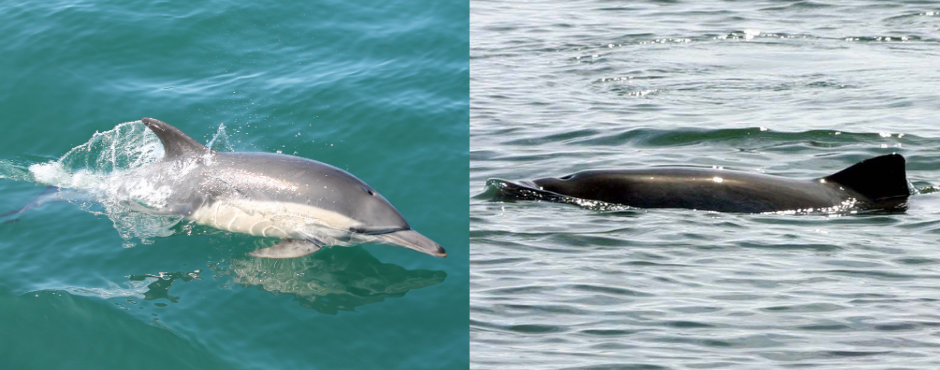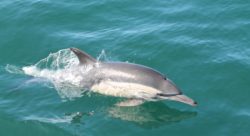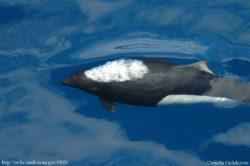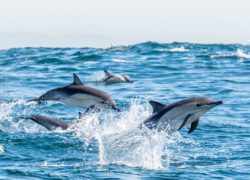
What’s the Difference? Dolphin vs. Porpoise
People often refer to dolphins and porpoises as the same kind of animal and are surprised to find out that, while they do have similarities, they are different animals. Both are cetaceans (toothed whales) and they have similar coloration and characteristics like being some of the most playful, charismatic creatures of the sea. However, they do have some distinct differences, most obviously seen in their faces, fins, and figures. Learn more below about what makes these animals similar and different below so you can tell them apart!
Dolphins (Delphindae family)
Dolphins are more widely distributed in the ocean and more commonly seen, especially in temperate and tropical waters.
There are at least 32 known species of dolphins.
Dolphins are very active and more social than porpoises. They tend to live in larger and more stable groups and have been found to form megapods, large social groups, during times of feeding or mating.
They are more extroverted than porpoises! Dolphins are very active on the surface, living in large pods, and more “talkative,” making sounds like squeaks, whistles, clicks and more. They are also more likely to approach humans and boats on the surface.
Dolphins have bulbous heads with elongated jaws that form their “beaks”, inside of which are cone-shaped teeth used for grasping and trapping prey before swallowing it whole.
They are leaner and longer than porpoises, averaging about 6 to 12 feet in length. On their backs are prominent and more curved dorsal fins, and they are able to move their heads from side to side independent of the rest of their bodies.

Common dolphin swimming in Channel Islands National Marine Sanctuary. Photo: John Burke
Porpoises (Phocoenidae family)
Porpoises have a smaller geographic range than dolphins. They are generally found in the colder waters of the northern Atlantic and Pacific oceans, and live closer to shore.
We only know of seven species of porpoise.
Porpoises are generally more timid than dolphins and travel alone or in small social groups of two or three individuals.
Porpoise also “talk” with similar sounds but they have less diverse vocalizations
They tend to be shorter and more stout than dolphins, reaching maximum lengths of around seven feet when fully grown.
They have rounded heads, blunt jaws (in comparison to the beak of a dolphin), and triangular dorsal fins that resemble those of sharks. They have smaller mouths and spade-shaped teeth. Porpoises cannot move their heads from side to side without the rest of their body following due to their fused vertebrae.

Harbor porpoise. Photo: NOAA
Both
Both are part of the order cetacea, which comes from the greek word “ketos”, which means large sea creatures.
Dolphins and porpoises are social, highly perceptive, and intelligent animals with complex brains.
They have oil-filled foreheads called melons, which help them in amplifying biological sonar waves they produce by pushing air through their blowholes. These sound waves help them “see” with sound in a process called echolocation.
Both dolphins and porpoises receive sound waves in their hollow, lower jaws, which transmit those waves to their ear and then their brains, helping them see solid objects like prey or obstacles in the water.
Both animals produce whistles and clicks to communicate with one another, and possibly other whale, dolphin, and porpoise species. Scientists and the public are enamored with this mysterious way of communicating that we still don’t know much about. Dolphins tend to be more vocal, possibly because they have fewer predators and, thus, less risk if they are heard.
Neither has a sense of smell. This is because their blowholes, which they consciously control, remain closed underwater, and smell is carried by air.
Both are charismatic, curious, and playful animals, performing unique behaviors like fin slaps, leaps out of the water, and swimming at burst speeds.
Both can also be found in nearly all of the oceanic sites within the National Marine Sanctuary System.
Like all marine mammals, dolphins and porpoises are protected under the Marine Mammal Protection Act of 1972 and some are also listed under the Endangered Species Act. These cetaceans play an important role in the overall balance of the marine environment as they are at the top of the food chain. They are often referred to as “sentinels” of ocean health as they provide insight into marine ecosystem dynamics and numerous studies on these animals help us understand human impacts on the ocean. Both their populations face threats like accidental bycatch, entanglement in fishing gear, climate change, ship strikes, plastic and noise pollution, and habitat loss.

Dall’s Porpoise. Photo: Cornelia Oedekoven/NOAA

Common dolphins. Photo: Douglas Croft
